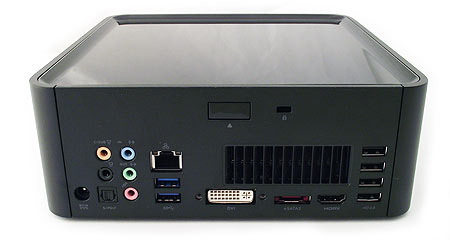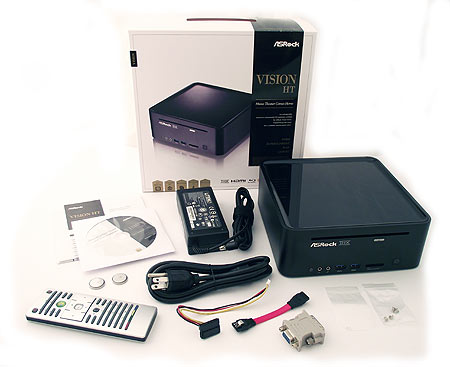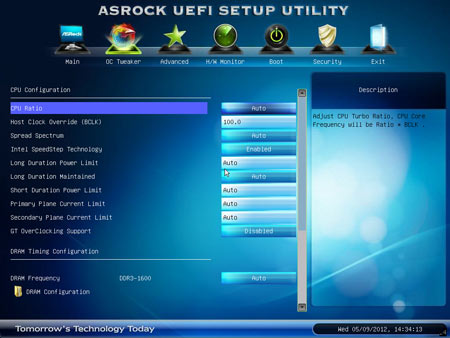Does Size Matter? Four Very Small Nettops Get Reviewed
We're comparing four diminutive PCs: ASRock’s Vision HT, Jetway’s Mini-Top JBC700, Lenovo’s Q180, and Zotac’s Zbox Nano XS AD11 Plus. Despite their similar sizes, each tiny computer offers a unique feature set. Are any of them right for you?
ASRock Vision HT 321B
ASRock set a high bar for home theater-oriented PCs with its Sandy Bridge-equipped Core HT, a very small machine sporting impressive internals. Its replacement, the Vision HT, improves on that system using an Ivy Bridge-based Core i5-2120M CPU and Intel HD Graphics 4000. Intel's dual-core, Hyper-Threaded processor runs at 2.5 GHz and can accelerate to 3.1 GHz by virtue of Turbo Boost, making it the fastest chip in our round-up.
With a $680 price tag on Newegg, this is also the most expensive model in our story. That's the price you pay for capable hardware, though.
The Vision HT scraps its predecessor's glossy black enclosure in favor of the design used on ASRock's Vision 3D, a previous flagship with Nvidia 3D Vision support. Although it shares the Core HT's 7.5” x 7.5” x 2.75” dimensions, it's a lot classier-looking now, sporting a brushed metal finish all around.
The system's rear output panel offers HDMI and DVI video outputs, an eSATA connector that can also be used as a USB port, six USB ports (two of which are USB 3.0), gigabit Ethernet, the power supply connector, optical audio output, and five 1/8" analog audio jacks.
When you add in the two USB 3.0 ports up front, ASRock's Vision HT 321B comes with a total of eight connectors, which is actually three less than the Core HT 252B. We're OK with that; 11 ports were overkill anyway.
The front panel also features headphone output and microphone input jacks, a memory card reader, an infrared receiver for the remote, and a requisite power button.
The system comes with an external power supply, a driver CD, a manual, a remote with two batteries, a DVI-to-VGA dongle, and extra cables for a second hard disk. The only necessity missing is an operating system, which is going to add the final price if you end up adding Windows. We would have preferred to see Windows 7 Home Premium 64-bit bundled.
Get Tom's Hardware's best news and in-depth reviews, straight to your inbox.
The included media center remote is clean and classy, but we’re not fans of the tiny rubber buttons. It does its job well enough, though, with a wide 170-degree arc of responsiveness. We were able to issue commands from up to about 14 feet away from the receiver.
Disassembly begins by removing the plastic top. A metal shield and a few more screws are all that remain, standing between you and the machine's internals. For the most part, then, making repairs and performing upgrades is a snap. ASRock populates the two memory slots with 4 GB (2 x 2) of 800 MHz DDR3 (1600 MT/s), and the board can handle a total of 16 GB if you want to upgrade later. Seagate's Momentus Spinpoint drive delivers a respectable 750 GB of capacity, though it spins at a relatively slow 5400 RPM. If you're looking for more storage performance, it might be worth dropping an mSATA-based boot drive into the vacant slot. Alternatively, you could install a second 2.5" SATA-based drive as well. Although it isn't visible in the shot above, the metal shield holds LG's DL-4ETS Slimline Blu-ray drive, the only Blu-ray offering in our round-up.
Some of the Vision HT's other noteworthy capabilities include Bluetooth 4.0 support and dual-band 2.4/5 GHz Wi-Fi radios. Both features are unique to ASRock in today's story.
The Vision HT also includes ASRock's suite of value-added software, including the Extreme Tuning Utility (for performance tuning and overclocking), App Charger (for fast device charging over USB), Instant Boot, XFast USB (for improved USB transfer rates), and XFast LAN (to prioritize network traffic). THX TruStudio audio processing software is also provided.
The GUI-driven UEFI, which we're already used to seeing from ASRock's desktop motherboards, is robust for a small form-factor PC, including RAM timing and voltage tweaks. You wouldn’t want to push settings too far on a cooling-constrained box like this one, but it's nice to have manual control if desired.
Current page: ASRock Vision HT 321B
Prev Page ASRock, Lenovo, Jetway, And Zotac: Small Form-Factor PCs Next Page Jetway Mini-Top JBC700C9JGDon Woligroski was a former senior hardware editor for Tom's Hardware. He has covered a wide range of PC hardware topics, including CPUs, GPUs, system building, and emerging technologies.
-
Nintendo Maniac 64 So I'm guessing there aren't any nettops yet that use the low-voltage Trinity APUs? (17w A6-4455M and 25w A10-4655M)Reply -
daglesj Beware with the Lenovo Q180 if you buy the barebones DOS version to install Windows 7 64bit on it.Reply
The Audio doesn't work. The drivers Lenovo have up on the site are incorrect for 64bit. So far they haven't got round to changing it after 6 months.
If you buy the version with Windows 64bit installed it works. But they just wont release the right driver. -
The big problem with net tops is longevity and lack of upgrade abilities. If all you plan to do with them is surf the web,send email, chat and watch 2D video. You most likely won't care what hardware is in them. But that's not the negative about these small form factors. Its heat, and a question of how that heat will affect the hardware in such a small form? Not to mention the small PSU's and the question of why would you buy one of these over a decent well designed notebook? Even if you like the form factor and want to run Linux on one of these. Chances are Linux will challenge you on some problem with the hardware.Reply
-
daglesj For day to day office work they do the job perfectly. I know quite a few businesses that are keen to drop their old 130W desktop boxes for something easier on the power bill. I rolled out a load of Atom ION boxes about 3 years ago and all of them are still going strong in some quite challenging environments. A few of them were even overclocked to give a little extra pep and no problems yet.Reply
The main thing that holds these boxes back are the HDDs. They still keep slipping 5400rpm drives in them. You put a 120GB SSD in there and you have a near perfect general office PC. -
silverblue Looking at the D2700 vs. the 450 reminds me of days gone by with the P4D and the Athlon 64 X2. The higher clock speed plus HT of the Atom helps a lot with encoding but despite its clock speed disadvantage, the 450 easily holds its own.Reply
The next generation of both these CPU families would be worth watching out for. -
jaquith I've been debating about purchasing a MINI PC vs Building, sadly one of my HTPC's just recently took a swan dive. So do I purchase something like the ASRock Vision HT for ~$700+ ($800), Build or Repair?!Reply
The only potential drawback to these MINI PC's as an HTPC is lacking of an internal 'TV Tuner' option. However, since Cable DVR's are very common place now the 'TV Tuner' need is getting smaller every day. I have Verizon FiOS and the newer black DVR's and a HTPC to record requires a CableCARD and PCIe CableCARD e.g. Ceton InfiniTV 4 but then you run into oddball things like "Copy Once."
The Pro's & Con's are all from their size, but ~$700+ is a huge price and IMO reduces the demand. The only complete system in this article is the Lenovo Q180, the ASRock Vision HT 821B requires some form of OS and sure there's 'free' OSes but Windows 7 Home Premium OEM 64-bit will add an additional $100.
Any of these listed can be used as a simple Desktop replacement. The workaround for storage is to either purchase a large capacity 'drive' (SSD or HDD) that can 'fit' or some form of external storage including an external drive (USB or eSATA if applicable) or Windows Home Server or similar network storage device. -
chewy1963 silverblueLooking at the D2700 vs. the 450 reminds me of days gone by with the P4D and the Athlon 64 X2. The higher clock speed plus HT of the Atom helps a lot with encoding but despite its clock speed disadvantage, the 450 easily holds its own.The next generation of both these CPU families would be worth watching out for.Reply
Just about the same performance between them back in the day. Of course it's different OS's and software, but, that was from the good ole days when Athlon 64 x2 ruled the x86 performance race. -
stevelord I bought an Asus nettop last year from Walmart. And despite putting a SSD in it + 4GB of memory, it crawled at even loading web pages...especially forums. Wife noticed the speed difference and after lots of complaining sent me back to return it.Reply
-
cleeve Nintendo Maniac 64So I'm guessing there aren't any nettops yet that use the low-voltage Trinity APUs? (17w A6-4455M and 25w A10-4655M)Reply
I couldn't find any, but this article has been in the works for a while so some might have cropped up. -
cleeve jaquithThe only potential drawback to these MINI PC's as an HTPC is lacking of an internal 'TV Tuner' option.Reply
The Jetway Mini-Top in this article *does* have an internal TV tuner option. :)






